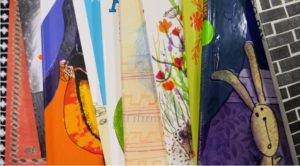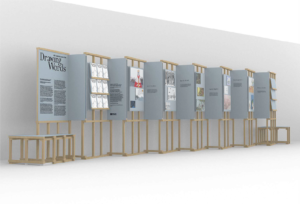| Drawing Words Exhibition
Gail Ellis |
Download PDF |
Figure 1: The Drawing Words website image
Drawing Words is an exhibition of children’s picturebooks organised by the British Council and curated by Lauren Child, the UK’s Children’s Laureate (2017–2019). The exhibition features ten illustrators from across the UK whose work makes an important and original contribution to contemporary British picturebook illustrations. Each illustrator uses different techniques to tell stories that show new perspectives on the world around us.
Drawing Words is inspired by Magic Pencil, an exhibition of children’s book illustration selected by the first UK Children’s Laureate Quentin Blake in 2002, which also included Lauren Child’s work in her early career. Regarding the title of the exhibition, Lauren Child explains that it is …
… in one sense deceptive in its simplicity. If it did not need to be pithy, and there was space for it on the poster, I might add, to Drawing Words, drawing the meaning beyond the words, conjuring emotion and atmosphere, creating a visual world you can understand at a glance or decipher over time. This is what the best illustrators strive to do. They seek the meaning contained in the words and beyond the words. The more you look the more you see, the more you see the more you understand. (Child, 2018, p. 2) [end of page 81]
In an English language teaching context, the title of the exhibition highlights the multimodal aspect of a picturebook: the combination of words and pictures. The verb that would most commonly collocate with ‘words’ is writing, that is writing words, but the title, Drawing Words, reflects the illustrator’s task, as Child states above, to draw ‘the meaning contained in the words and beyond the words’.
Drawing Words Artists
As Lauren Child explains:
The ten artists have developed unique ways of telling a narrative visually. The selection of these illustrators is itself personal and idiosyncratic. Like poetry, an illustrator creates a piece that can be looked at over and over again and interpreted differently each time. (Child, 2018, p. 3)
The artists are: Jill Calder, Lauren Carlin, Rebecca Cobb, William Grill, Emily Hughes, Yasmeen Ismail, Neal Layton, David Mackintosh, Emily Rand and David Roberts. The exhibition features illustrations from one book created by each of these artists. Two of my favourites are the books by Emily Rand and Emily Hughes.
I was delighted to discover the work of Emily Rand whose first book for children, A Dog Day (2014), is featured in the exhibition. I was immediately drawn in by the beautiful black and white pen and ink drawings which convey an array of textures, tones, shapes and patterns in an urban landscape. In the words of Lauren Child (2018, p. 3), ‘Notice how extraordinary the ordinary can be once drawn in black and white and bricks, pavements and tiles have been translated into pattern’. The story is told in rhyming couplets across each double spread which develops children’s phonological awareness and prediction skills. I also discovered the work of Emily Hughes for the first time. Her intricate, decorative and colourful illustrations of a painted woodland in Wild (2015) contrast with those of Emily Rand’s. The ten artists featured in the exhibition each have their own unique style and a variety of picturebooks are included: rhyming stories; picturebooks where the text states one thing and illustrations show another; graphic style illustrations; photographs of everyday objects which are created into characters, creatures and worlds and non-fiction. Each person will interpret the picturebooks in their own personal way. [end of page 82]
Audiences
Drawing Words is designed to appeal to a wide range of audiences. It brings the opportunity for partnerships across design, literature and education. Adults, particularly those with an interest in the design, illustration, literature, publishing and education sectors, will enjoy the opportunity to discover and be challenged by new work from the UK. Audiences are invited to consider the illustrations from a new perspective, lifted from the page and hung within an exhibition context. New clues emerge about narrative and context when we take time to consider the work, highlighting the way the selected illustrators convey complex ideas and emotions in deceptively simple, visual forms.
Teachers can use the exhibition as a tool for encouraging young people to be creative, build empathy and consider different ways of working with picturebooks in the English language classroom. Children will enjoy the range of illustration presented in an accessible way. They can spot clues about the characters and the stories told, and be inspired by the work they see and given the space to think about the world around them in different ways. Children are introduced to new books, writers and illustrators.
Venues
Figure 2: Drawing Words on display
Drawing Words can be displayed in a variety of venues including art, design or university galleries, libraries, book shops, book fairs and schools. The exhibition has a flexible and modular layout so that it can be adapted to spaces of different sizes. The [end of page 83] display system is designed to be built on location, and the artwork is available to print locally to specific requirements. A package of books featuring the illustrators included in Drawing Words is available to buy. A minimum of one pack is required to display within the exhibition and additional packs may be purchased to support additional wraparound programmes or for library use. Drawing Words is supported by an exhibition website which can be used as a resource for wraparound programmes. It includes video interviews with the ten selected illustrators in their studios, a conversation with the curator, Lauren Child, and images from the exhibition.
A pamphlet is available to accompany the exhibition. It features information about each of the ten selected illustrators, and an introduction by the curator, Lauren Child. It is designed to be printed locally and can be made available in translation.
Educational Resources
Figure 3: The cover of ‘Creative Worksheets’ for children
There are a variety of downloadable educational resources which provide helpful ideas for using picturebooks with or without the exhibition or with the exhibition website:
- Creative Worksheets for children have been designed by the House of Illustration, and are for families or schools to be used alongside the physical or digital exhibition.
- Teaching Resources are designed to encourage teachers to use illustrations and picturebooks in their classrooms to promote knowledge and transferable skills, [end of page 84] including critical thinking, inference, and creativity, visual and emotional literacy. They include background information, discussion points and activities to promote learning across the curriculum. There are general activities and others that are linked to specific books and illustrations from the exhibition. The resources can be used at the exhibition, in individual lessons or as elements of a joint cross-curricular project in classrooms.
- English Language teaching notes: these lesson plans are aimed at primary-aged children and are designed to be used with A Dog Day by Emily Rand and Wild by Emily Hughes.
- Family Reading Toolkit: this guide has been developed by Family Arts Campaign and can be used to plan family reading events.
The Drawing Words exhibition showcases British picturebook illustration, and storytelling sessions for both children and their families can be organised around titles from the exhibition. The movable, scalable display panels allow the exhibition to travel anywhere in the world, and digital resources can be downloaded. Please see the British Council website for further information.
References
Child, L. (2018) Introduction. Exhibition Pamphlet. London: British Council.
Further Information
Drawing Words website
Magic Pencil website
Blake, Q. & Rose, A. (Eds.) (2002). Magic Pencil: Children’s Book Illustration Today. 2002. The British Council/The British Library.
Gail Ellis has over 30 years’ experience as a teacher, teacher educator and manager. Her recent publications include Tell it Again! and Teaching Children How to Learn. Her main [end of page 85] interests are picturebooks in ELT, young learner ELT management, inclusive practices and children’s rights. [end of page 86]




